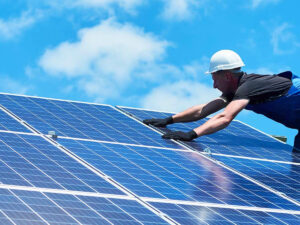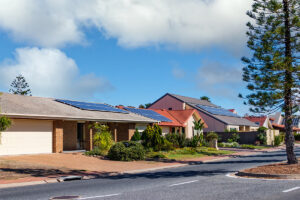Buying solar is about the same as everything else; you get what you pay for. If you buy the cheapest stuff on the market you can expect the lowest performance and unfortunately a high chance of failure.
For this exercise lets imagine you’ve checked your system and noticed that the inverter is on but it’s showing no power being produced. So you’ve checked your panels and noticed that one of them looks like waters got in and part of it has gone a milky white.
The nature of 99% of residential solar systems are constructed so that if one panel in a string fails, then the whole string can’t make any power. So you’re going to want to get that panel replaced pretty quickly! That’s when your warranty comes into play.
What components are covered
Warranties for solar systems typically cover different components of the system and may vary depending on the manufacturer and installer. Here are some common warranties to look out for when considering a solar system:
- Product Warranty: This warranty covers the solar panels themselves and typically ranges from 10 to 25 years. It guarantees that the panels will be free from defects and will maintain a certain level of performance over the specified period.
- Performance Warranty: This warranty ensures that the solar panels will maintain a certain level of power output over a specified period, typically 25 years. It guarantees that the panels will produce a certain percentage of their rated power output throughout their lifespan.
- Inverter Warranty: Inverters are an essential component of a solar system and typically come with warranties ranging from 5 to 12 years. The warranty covers any defects or malfunctions in the inverter during the specified period.
- Workmanship Warranty: This warranty is provided by the installer and covers the installation itself. It ensures that the installation was done correctly and free from defects. Workmanship warranties typically range from 1 to 10 years.
Things to consider
- Length of Warranty: Longer warranty periods generally indicate more confidence in the product’s durability and performance.
- Coverage: Ensure that the warranty covers both product defects and performance issues. It’s important to understand what is specifically covered and what is excluded.
- Transferability: Check if the warranties are transferable if you decide to sell your property. This can add value to your solar system when selling your home.
- Manufacturer/Installer Reputation: Research the reputation and track record of the manufacturer and installer offering the warranties. It’s important to choose reliable and reputable companies that are likely to honor their warranties.
- Warranty Terms and Conditions: Carefully review the terms and conditions of the warranties, including any requirements for maintenance, proper usage, and any exclusions that may void the warranty.
It’s recommended to work with a reputable installer who provides comprehensive warranties and can guide you through the details of each warranty associated with your solar system.
Types of warranties
There are two types of warranties on a panel:
- Workmanship/Materials (also on inverters)
- Performance

Workmanship/Materials
The workmanship/materials warranty covers the construction of the panel and would cover issues that may not have a massive effect on performance but still make it unsuitable for long term use.
An example would be if the DC connector points on the back aren’t mounted correctly and are loose. They may still allow electrical charge through but it’s not suitable for long term use.
Performance
Every panel has a performance warranty that guarantees the output of the panel for a set amount of time. These warranties vary from company to company but guarantee a certain level of output depending on how long the panel has been installed.
Generally there are two types, a step warranty or a linear warranty. If you can get it, a linear warranty is preferred and generally is only offered by higher quality panels because the company is more confident in their product.
So, under our hypothetical situation with 0% performance, due to workmanship problems we would reasonably be covered under both warranties.
This is where the difference in companies really sticks out.
What to watch out for in your warranty
To put it simply, your warranty should cover the end to end repair/replacement of your faulty unit, whether it is the inverter or the panel. For our panel situation that means:
- Removal of panel
- Transport to manufacturer
- Testing of panel (if required)
- Repair/Replacement
- Transport back to your premises
- Re-Installation
- Testing for system working
This is one of the points where getting what you pay for is definitely true. For the mid to higher end of the price scale the warranties generally cover this whole process and most companies have a presence in Australia which helps speed up the process.
On the lower end only the testing of the panel and repair/replacement is covered. That said, testing is only covered if they find a problem with the panel, otherwise you have to pay for that as well.
That means to get your warranty on your cheap panel means you have to pay for:
- Solar certified electrician to uninstall and remove panel
- Shipping to manufacturer (usually in China so customs fees apply)
- Possibly the testing of the panel
- Shipping back to you (again customs fees)
- Solar certified electrician to re-install and test panel
A quick call to customs Australia reveals that the shipping and customs charge for the two-way transport runs at about $1600 without all the other charges.
In the end, it would be cheaper to just buy a new panel.
Summary
When purchasing a solar system, check closely what the warranty action is if any component fails. On the cheaper gear, the warranty could not be worth the paper it’s written on if it doesn’t cover the end to end repair/replacement process.









